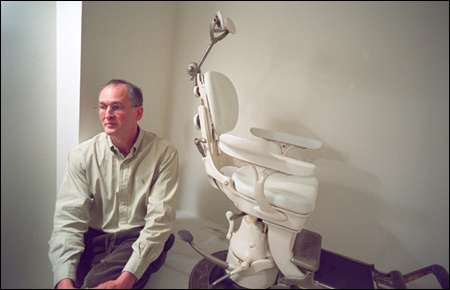The good, the bad, and the smelly:
Breathe easier: the cause of bad breath is identified

Most people have upward of 700 different bacteria living in their mouths. Some cause bad breath, while others may protect you from it. Dental researchers have known this for a long time but have difficulty telling which bacteria are which.
“Clearly, something is different in people with halitosis, otherwise everyone would have it,” says Bruce Paster, a researcher at the Forsyth Institute in Boston and an associate professor at the Harvard School of Dental Medicine.
He is part of a team from the Forsyth and the University of Michigan that has identified six bacteria living on the tongues of most everyone with bad breath whom they tested. Turning the other nostril, they discovered a different group of bacteria typically associated with fresh breath.
“In each of six individuals with halitosis, we found several species that were not found in those with fresh breath,” notes Paster. “Conversely, in five individuals with fresh breath we identified species not generally found in those with halitosis.”
Eleven subjects are not enough to get you into the dental hall of fame, but the study continues with 60 more people. “So far our findings are the same in this larger group,” Paster says.
These breathtaking investigations fit into a larger effort to map the genes of the hundreds of bacteria species that find the human mouth a warm and nutritious place to live.
Gene maps of their hosts, us, could reveal why some humans are susceptible to bad mouths and others revel in freshness. The combination of knowing the guilty bacteria and the genes of their hosts could lead to the ability to predict who will get halitosis as well as to new treatments for it.

Down in the mouth
The 700 (and still counting) bacteria live on gums, teeth, mouth lining, and tongues. The ones that give people bad breath – about one-third of Americans complain about it – hang out mostly at the back of the tongue. It’s an area not too well known. A close analysis of tongue scrapings found 92 different species, 29 of them never before identified. Paster draws the obvious conclusion: “There may well be additional species responsible for good and bad breath.”
Of course, there is some overlap between the two groups but it’s not of much consequence. Organisms present in high numbers in fresh mouths rarely appear in mouths with bad breath and vice versa.
These bacteria boast Velcro-like projections on their surfaces that adhere to so-called receptors on your tongue. Normally, good bacteria build a coating that prevents bad guys from forming colonies. When this process becomes interrupted, the latter get a hold. “We don’t have a good handle on how this happens,” Paster admits.
The malodorous residents break down proteins from food, saliva, and other compounds in your mouth, and this activity releases sulfur-containing compounds, which cause pungent breath.
The first step in evicting the smellsome organisms involves use of a tongue scraper. Drug stores sell them, often labeled as “tongue debriders.” Or you can just use a toothbrush on your tongue as you brush after every meal. If the tongue plaque is particularly tenacious, anti-microbial mouthwashes often do the job. “We are presently looking into a variety of such rinses to determine which ones work best on the bacteria we have identified,” Paster notes.
As mentioned, some people are more susceptible to halitosis than others. No one knows why but Paster and his colleagues hope to find out as part of their gene-mapping efforts. Microchips, which identify many genes at once, can be used to compare the active genes of people with sweet tongues to those with smelly mouths.
Then there’s the possibility of developing microbial rinses that would suppress the activities of one and support the activities of the others.
Sigmund Socransky at the Forsyth has tried to displace bad bacteria by swishing billions of good bacteria around his mouth and by packing them into his teeth. (No, he doesn’t have bad breath; it was an experiment.) So far, he hasn’t had much luck in getting them to take up permanent residence.
Jeff Hillman at the University of Florida is attempting to prevent or reduce cavities by pasting genetically engineered bacteria on teeth. Securely anchored on plaque, well-known microbes such as Streptococcus mutans produce an acid that erodes the hard enamel and starts the process of decay. If anti-bacteria bacteria can successfully colonize both tongues and teeth, people could enjoy fewer cavities as well as fresh breath.
Those working on breath problems with Paster include Floyd Dewhirst, a Forsyth researcher who is also an associate professor at Harvard School of Dental Medicine. The University of Michigan part of this study is led by Christopher Kazor and Walter Loesche, both of the School of Dentistry in Ann Arbor.




